Introduction to Criminal Justice: Policing in New South Wales Analysis
VerifiedAdded on 2022/08/27
|8
|2274
|26
Essay
AI Summary
This essay provides an overview of the policing models practiced in New South Wales (NSW), Australia, with a focus on the community-based policing model employed by the NSW Police Force. It critically examines the effectiveness of this model, its challenges, and the discretionary powers afforded to the police, particularly concerning the over-imprisonment of Aboriginal and Torres Strait Islander peoples. The essay contrasts the community-based model with the zero-tolerance policing model, highlighting the advantages and disadvantages of each. It references crime statistics from the NSW Police Department, suggesting that the community model has contributed to a decline in major crime categories. The essay concludes that while the community model has its challenges, it is currently beneficial for NSW, and a change in policing model is not necessary at this time. Desklib offers more resources for students.
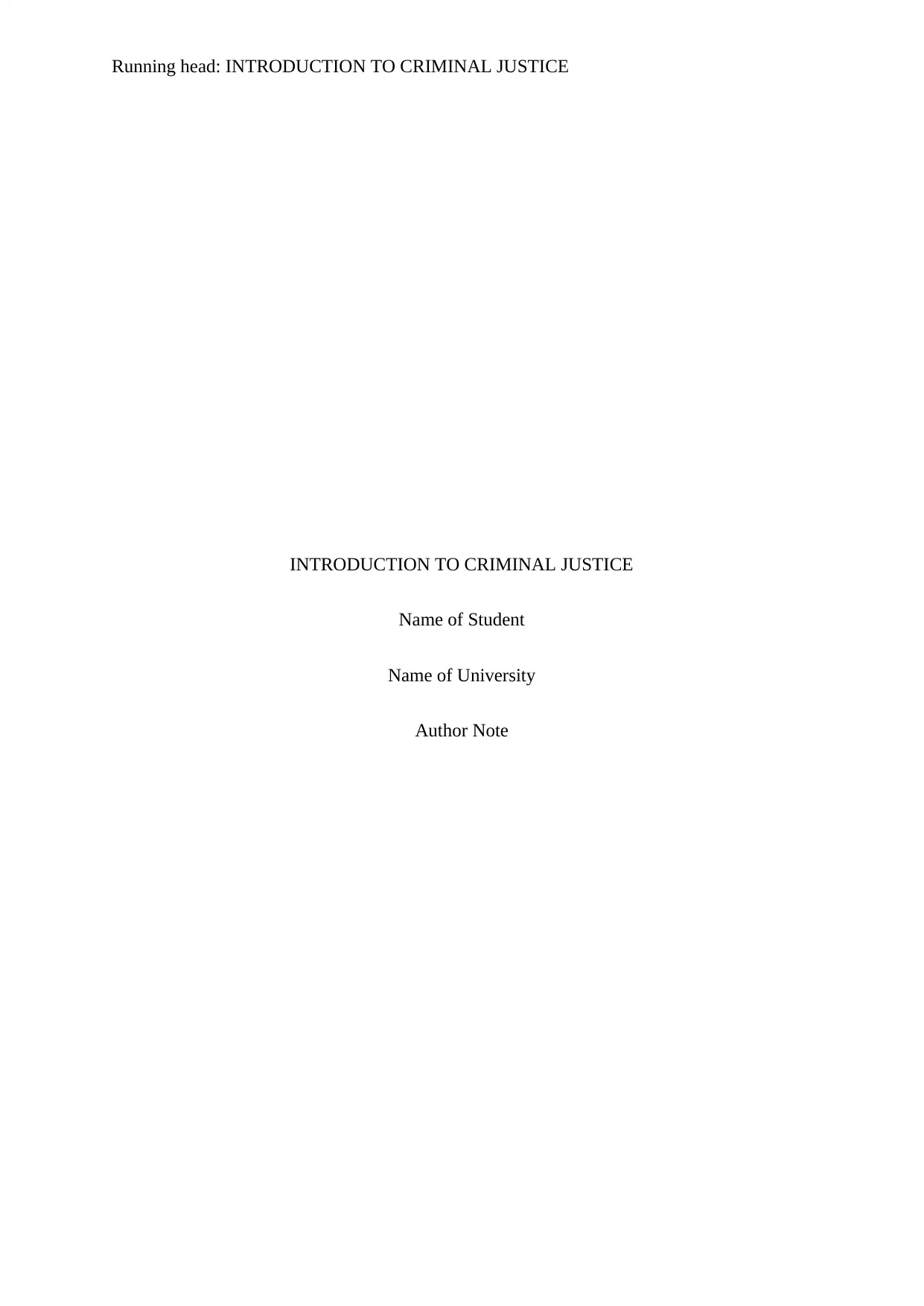
Running head: INTRODUCTION TO CRIMINAL JUSTICE
INTRODUCTION TO CRIMINAL JUSTICE
Name of Student
Name of University
Author Note
INTRODUCTION TO CRIMINAL JUSTICE
Name of Student
Name of University
Author Note
Paraphrase This Document
Need a fresh take? Get an instant paraphrase of this document with our AI Paraphraser
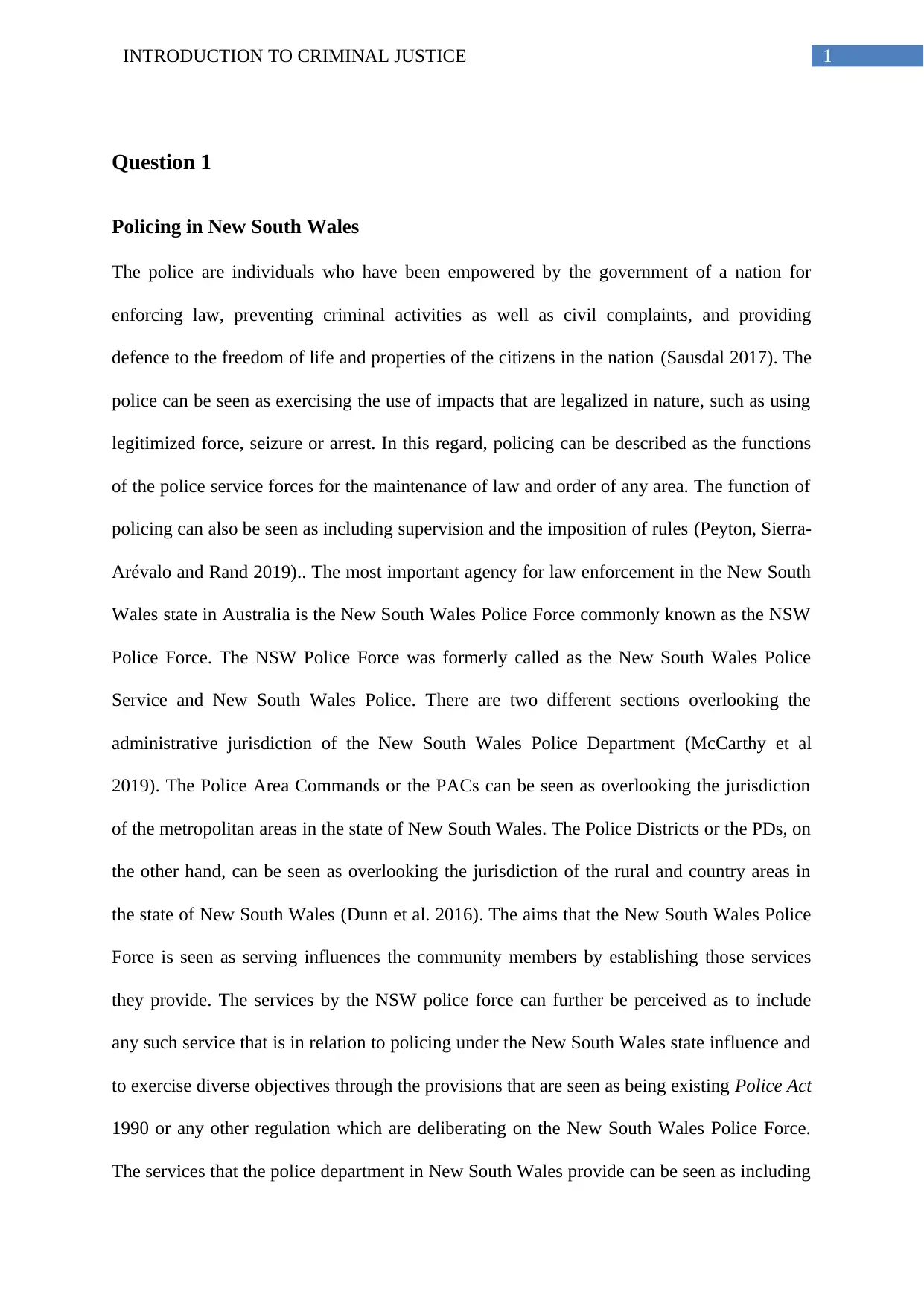
1INTRODUCTION TO CRIMINAL JUSTICE
Question 1
Policing in New South Wales
The police are individuals who have been empowered by the government of a nation for
enforcing law, preventing criminal activities as well as civil complaints, and providing
defence to the freedom of life and properties of the citizens in the nation (Sausdal 2017). The
police can be seen as exercising the use of impacts that are legalized in nature, such as using
legitimized force, seizure or arrest. In this regard, policing can be described as the functions
of the police service forces for the maintenance of law and order of any area. The function of
policing can also be seen as including supervision and the imposition of rules (Peyton, Sierra-
Arévalo and Rand 2019).. The most important agency for law enforcement in the New South
Wales state in Australia is the New South Wales Police Force commonly known as the NSW
Police Force. The NSW Police Force was formerly called as the New South Wales Police
Service and New South Wales Police. There are two different sections overlooking the
administrative jurisdiction of the New South Wales Police Department (McCarthy et al
2019). The Police Area Commands or the PACs can be seen as overlooking the jurisdiction
of the metropolitan areas in the state of New South Wales. The Police Districts or the PDs, on
the other hand, can be seen as overlooking the jurisdiction of the rural and country areas in
the state of New South Wales (Dunn et al. 2016). The aims that the New South Wales Police
Force is seen as serving influences the community members by establishing those services
they provide. The services by the NSW police force can further be perceived as to include
any such service that is in relation to policing under the New South Wales state influence and
to exercise diverse objectives through the provisions that are seen as being existing Police Act
1990 or any other regulation which are deliberating on the New South Wales Police Force.
The services that the police department in New South Wales provide can be seen as including
Question 1
Policing in New South Wales
The police are individuals who have been empowered by the government of a nation for
enforcing law, preventing criminal activities as well as civil complaints, and providing
defence to the freedom of life and properties of the citizens in the nation (Sausdal 2017). The
police can be seen as exercising the use of impacts that are legalized in nature, such as using
legitimized force, seizure or arrest. In this regard, policing can be described as the functions
of the police service forces for the maintenance of law and order of any area. The function of
policing can also be seen as including supervision and the imposition of rules (Peyton, Sierra-
Arévalo and Rand 2019).. The most important agency for law enforcement in the New South
Wales state in Australia is the New South Wales Police Force commonly known as the NSW
Police Force. The NSW Police Force was formerly called as the New South Wales Police
Service and New South Wales Police. There are two different sections overlooking the
administrative jurisdiction of the New South Wales Police Department (McCarthy et al
2019). The Police Area Commands or the PACs can be seen as overlooking the jurisdiction
of the metropolitan areas in the state of New South Wales. The Police Districts or the PDs, on
the other hand, can be seen as overlooking the jurisdiction of the rural and country areas in
the state of New South Wales (Dunn et al. 2016). The aims that the New South Wales Police
Force is seen as serving influences the community members by establishing those services
they provide. The services by the NSW police force can further be perceived as to include
any such service that is in relation to policing under the New South Wales state influence and
to exercise diverse objectives through the provisions that are seen as being existing Police Act
1990 or any other regulation which are deliberating on the New South Wales Police Force.
The services that the police department in New South Wales provide can be seen as including
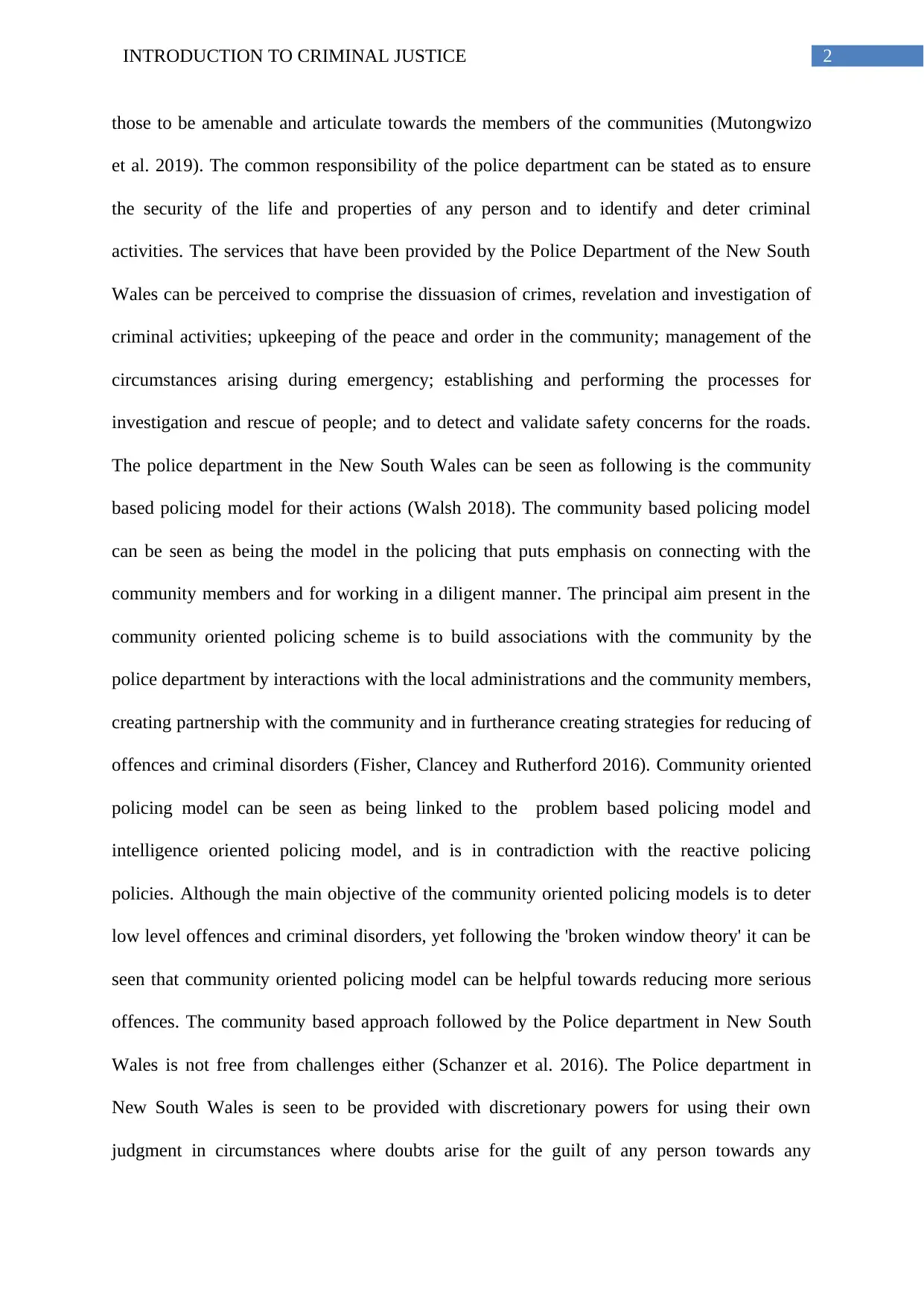
2INTRODUCTION TO CRIMINAL JUSTICE
those to be amenable and articulate towards the members of the communities (Mutongwizo
et al. 2019). The common responsibility of the police department can be stated as to ensure
the security of the life and properties of any person and to identify and deter criminal
activities. The services that have been provided by the Police Department of the New South
Wales can be perceived to comprise the dissuasion of crimes, revelation and investigation of
criminal activities; upkeeping of the peace and order in the community; management of the
circumstances arising during emergency; establishing and performing the processes for
investigation and rescue of people; and to detect and validate safety concerns for the roads.
The police department in the New South Wales can be seen as following is the community
based policing model for their actions (Walsh 2018). The community based policing model
can be seen as being the model in the policing that puts emphasis on connecting with the
community members and for working in a diligent manner. The principal aim present in the
community oriented policing scheme is to build associations with the community by the
police department by interactions with the local administrations and the community members,
creating partnership with the community and in furtherance creating strategies for reducing of
offences and criminal disorders (Fisher, Clancey and Rutherford 2016). Community oriented
policing model can be seen as being linked to the problem based policing model and
intelligence oriented policing model, and is in contradiction with the reactive policing
policies. Although the main objective of the community oriented policing models is to deter
low level offences and criminal disorders, yet following the 'broken window theory' it can be
seen that community oriented policing model can be helpful towards reducing more serious
offences. The community based approach followed by the Police department in New South
Wales is not free from challenges either (Schanzer et al. 2016). The Police department in
New South Wales is seen to be provided with discretionary powers for using their own
judgment in circumstances where doubts arise for the guilt of any person towards any
those to be amenable and articulate towards the members of the communities (Mutongwizo
et al. 2019). The common responsibility of the police department can be stated as to ensure
the security of the life and properties of any person and to identify and deter criminal
activities. The services that have been provided by the Police Department of the New South
Wales can be perceived to comprise the dissuasion of crimes, revelation and investigation of
criminal activities; upkeeping of the peace and order in the community; management of the
circumstances arising during emergency; establishing and performing the processes for
investigation and rescue of people; and to detect and validate safety concerns for the roads.
The police department in the New South Wales can be seen as following is the community
based policing model for their actions (Walsh 2018). The community based policing model
can be seen as being the model in the policing that puts emphasis on connecting with the
community members and for working in a diligent manner. The principal aim present in the
community oriented policing scheme is to build associations with the community by the
police department by interactions with the local administrations and the community members,
creating partnership with the community and in furtherance creating strategies for reducing of
offences and criminal disorders (Fisher, Clancey and Rutherford 2016). Community oriented
policing model can be seen as being linked to the problem based policing model and
intelligence oriented policing model, and is in contradiction with the reactive policing
policies. Although the main objective of the community oriented policing models is to deter
low level offences and criminal disorders, yet following the 'broken window theory' it can be
seen that community oriented policing model can be helpful towards reducing more serious
offences. The community based approach followed by the Police department in New South
Wales is not free from challenges either (Schanzer et al. 2016). The Police department in
New South Wales is seen to be provided with discretionary powers for using their own
judgment in circumstances where doubts arise for the guilt of any person towards any
⊘ This is a preview!⊘
Do you want full access?
Subscribe today to unlock all pages.

Trusted by 1+ million students worldwide
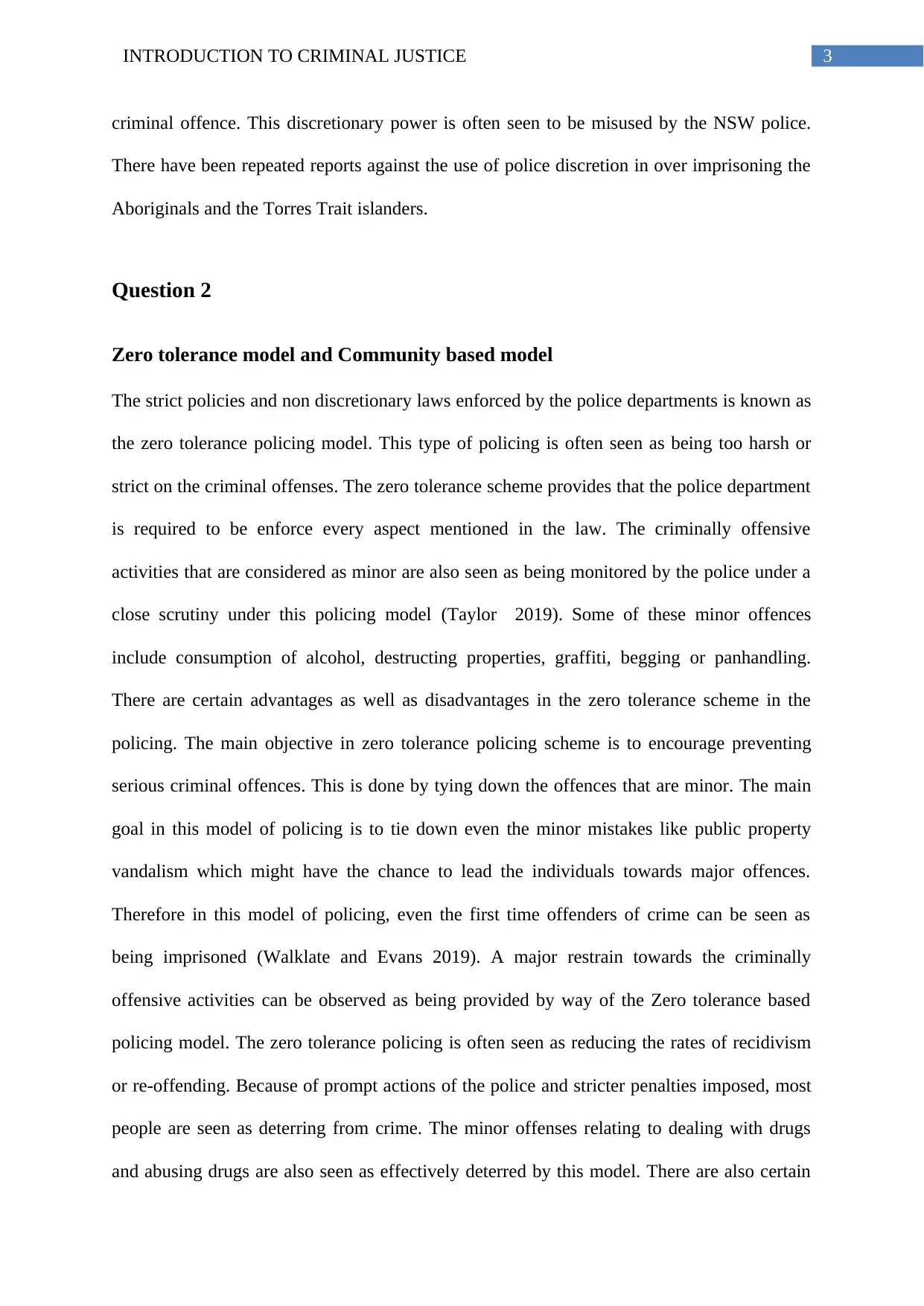
3INTRODUCTION TO CRIMINAL JUSTICE
criminal offence. This discretionary power is often seen to be misused by the NSW police.
There have been repeated reports against the use of police discretion in over imprisoning the
Aboriginals and the Torres Trait islanders.
Question 2
Zero tolerance model and Community based model
The strict policies and non discretionary laws enforced by the police departments is known as
the zero tolerance policing model. This type of policing is often seen as being too harsh or
strict on the criminal offenses. The zero tolerance scheme provides that the police department
is required to be enforce every aspect mentioned in the law. The criminally offensive
activities that are considered as minor are also seen as being monitored by the police under a
close scrutiny under this policing model (Taylor 2019). Some of these minor offences
include consumption of alcohol, destructing properties, graffiti, begging or panhandling.
There are certain advantages as well as disadvantages in the zero tolerance scheme in the
policing. The main objective in zero tolerance policing scheme is to encourage preventing
serious criminal offences. This is done by tying down the offences that are minor. The main
goal in this model of policing is to tie down even the minor mistakes like public property
vandalism which might have the chance to lead the individuals towards major offences.
Therefore in this model of policing, even the first time offenders of crime can be seen as
being imprisoned (Walklate and Evans 2019). A major restrain towards the criminally
offensive activities can be observed as being provided by way of the Zero tolerance based
policing model. The zero tolerance policing is often seen as reducing the rates of recidivism
or re-offending. Because of prompt actions of the police and stricter penalties imposed, most
people are seen as deterring from crime. The minor offenses relating to dealing with drugs
and abusing drugs are also seen as effectively deterred by this model. There are also certain
criminal offence. This discretionary power is often seen to be misused by the NSW police.
There have been repeated reports against the use of police discretion in over imprisoning the
Aboriginals and the Torres Trait islanders.
Question 2
Zero tolerance model and Community based model
The strict policies and non discretionary laws enforced by the police departments is known as
the zero tolerance policing model. This type of policing is often seen as being too harsh or
strict on the criminal offenses. The zero tolerance scheme provides that the police department
is required to be enforce every aspect mentioned in the law. The criminally offensive
activities that are considered as minor are also seen as being monitored by the police under a
close scrutiny under this policing model (Taylor 2019). Some of these minor offences
include consumption of alcohol, destructing properties, graffiti, begging or panhandling.
There are certain advantages as well as disadvantages in the zero tolerance scheme in the
policing. The main objective in zero tolerance policing scheme is to encourage preventing
serious criminal offences. This is done by tying down the offences that are minor. The main
goal in this model of policing is to tie down even the minor mistakes like public property
vandalism which might have the chance to lead the individuals towards major offences.
Therefore in this model of policing, even the first time offenders of crime can be seen as
being imprisoned (Walklate and Evans 2019). A major restrain towards the criminally
offensive activities can be observed as being provided by way of the Zero tolerance based
policing model. The zero tolerance policing is often seen as reducing the rates of recidivism
or re-offending. Because of prompt actions of the police and stricter penalties imposed, most
people are seen as deterring from crime. The minor offenses relating to dealing with drugs
and abusing drugs are also seen as effectively deterred by this model. There are also certain
Paraphrase This Document
Need a fresh take? Get an instant paraphrase of this document with our AI Paraphraser
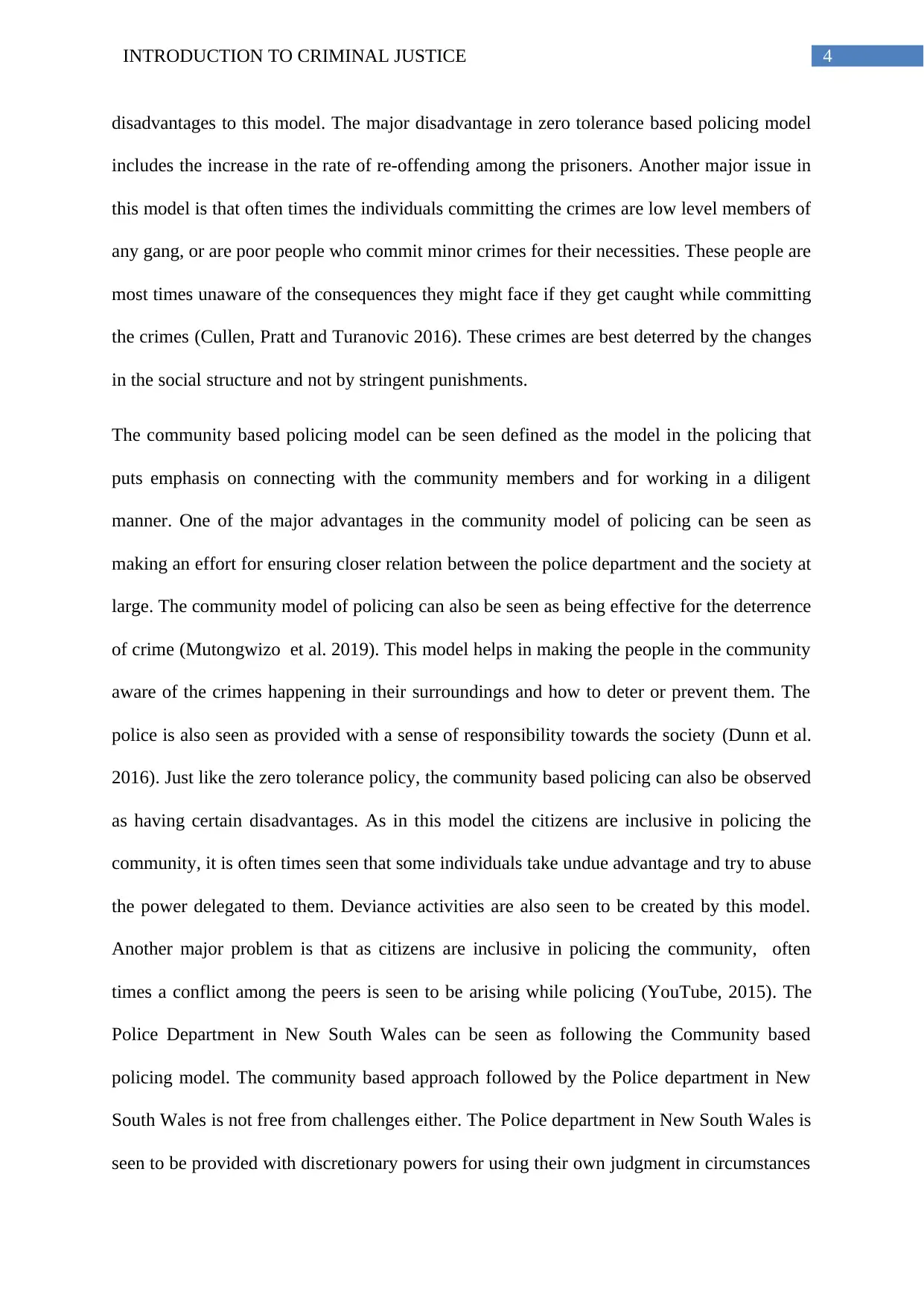
4INTRODUCTION TO CRIMINAL JUSTICE
disadvantages to this model. The major disadvantage in zero tolerance based policing model
includes the increase in the rate of re-offending among the prisoners. Another major issue in
this model is that often times the individuals committing the crimes are low level members of
any gang, or are poor people who commit minor crimes for their necessities. These people are
most times unaware of the consequences they might face if they get caught while committing
the crimes (Cullen, Pratt and Turanovic 2016). These crimes are best deterred by the changes
in the social structure and not by stringent punishments.
The community based policing model can be seen defined as the model in the policing that
puts emphasis on connecting with the community members and for working in a diligent
manner. One of the major advantages in the community model of policing can be seen as
making an effort for ensuring closer relation between the police department and the society at
large. The community model of policing can also be seen as being effective for the deterrence
of crime (Mutongwizo et al. 2019). This model helps in making the people in the community
aware of the crimes happening in their surroundings and how to deter or prevent them. The
police is also seen as provided with a sense of responsibility towards the society (Dunn et al.
2016). Just like the zero tolerance policy, the community based policing can also be observed
as having certain disadvantages. As in this model the citizens are inclusive in policing the
community, it is often times seen that some individuals take undue advantage and try to abuse
the power delegated to them. Deviance activities are also seen to be created by this model.
Another major problem is that as citizens are inclusive in policing the community, often
times a conflict among the peers is seen to be arising while policing (YouTube, 2015). The
Police Department in New South Wales can be seen as following the Community based
policing model. The community based approach followed by the Police department in New
South Wales is not free from challenges either. The Police department in New South Wales is
seen to be provided with discretionary powers for using their own judgment in circumstances
disadvantages to this model. The major disadvantage in zero tolerance based policing model
includes the increase in the rate of re-offending among the prisoners. Another major issue in
this model is that often times the individuals committing the crimes are low level members of
any gang, or are poor people who commit minor crimes for their necessities. These people are
most times unaware of the consequences they might face if they get caught while committing
the crimes (Cullen, Pratt and Turanovic 2016). These crimes are best deterred by the changes
in the social structure and not by stringent punishments.
The community based policing model can be seen defined as the model in the policing that
puts emphasis on connecting with the community members and for working in a diligent
manner. One of the major advantages in the community model of policing can be seen as
making an effort for ensuring closer relation between the police department and the society at
large. The community model of policing can also be seen as being effective for the deterrence
of crime (Mutongwizo et al. 2019). This model helps in making the people in the community
aware of the crimes happening in their surroundings and how to deter or prevent them. The
police is also seen as provided with a sense of responsibility towards the society (Dunn et al.
2016). Just like the zero tolerance policy, the community based policing can also be observed
as having certain disadvantages. As in this model the citizens are inclusive in policing the
community, it is often times seen that some individuals take undue advantage and try to abuse
the power delegated to them. Deviance activities are also seen to be created by this model.
Another major problem is that as citizens are inclusive in policing the community, often
times a conflict among the peers is seen to be arising while policing (YouTube, 2015). The
Police Department in New South Wales can be seen as following the Community based
policing model. The community based approach followed by the Police department in New
South Wales is not free from challenges either. The Police department in New South Wales is
seen to be provided with discretionary powers for using their own judgment in circumstances
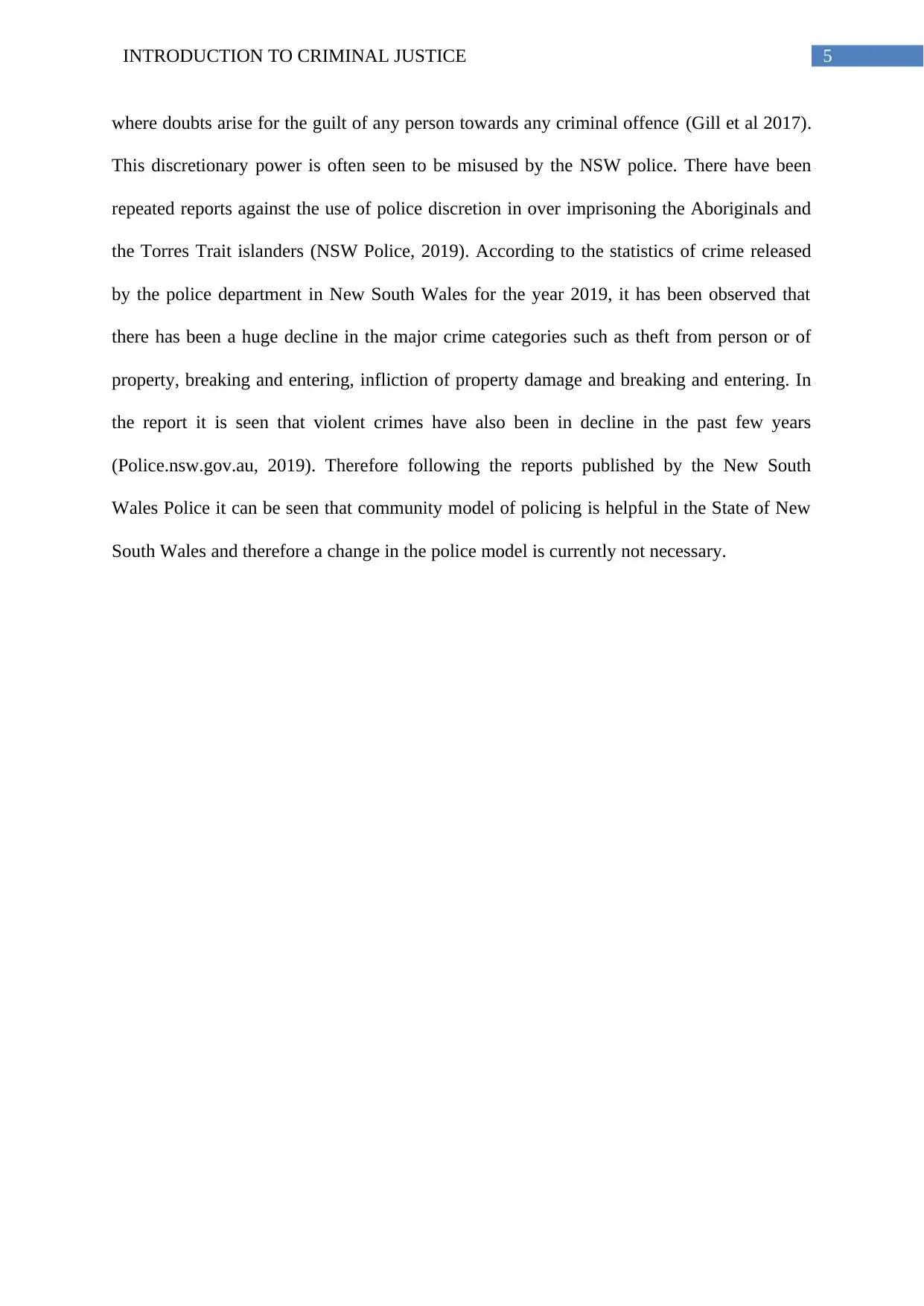
5INTRODUCTION TO CRIMINAL JUSTICE
where doubts arise for the guilt of any person towards any criminal offence (Gill et al 2017).
This discretionary power is often seen to be misused by the NSW police. There have been
repeated reports against the use of police discretion in over imprisoning the Aboriginals and
the Torres Trait islanders (NSW Police, 2019). According to the statistics of crime released
by the police department in New South Wales for the year 2019, it has been observed that
there has been a huge decline in the major crime categories such as theft from person or of
property, breaking and entering, infliction of property damage and breaking and entering. In
the report it is seen that violent crimes have also been in decline in the past few years
(Police.nsw.gov.au, 2019). Therefore following the reports published by the New South
Wales Police it can be seen that community model of policing is helpful in the State of New
South Wales and therefore a change in the police model is currently not necessary.
where doubts arise for the guilt of any person towards any criminal offence (Gill et al 2017).
This discretionary power is often seen to be misused by the NSW police. There have been
repeated reports against the use of police discretion in over imprisoning the Aboriginals and
the Torres Trait islanders (NSW Police, 2019). According to the statistics of crime released
by the police department in New South Wales for the year 2019, it has been observed that
there has been a huge decline in the major crime categories such as theft from person or of
property, breaking and entering, infliction of property damage and breaking and entering. In
the report it is seen that violent crimes have also been in decline in the past few years
(Police.nsw.gov.au, 2019). Therefore following the reports published by the New South
Wales Police it can be seen that community model of policing is helpful in the State of New
South Wales and therefore a change in the police model is currently not necessary.
⊘ This is a preview!⊘
Do you want full access?
Subscribe today to unlock all pages.

Trusted by 1+ million students worldwide
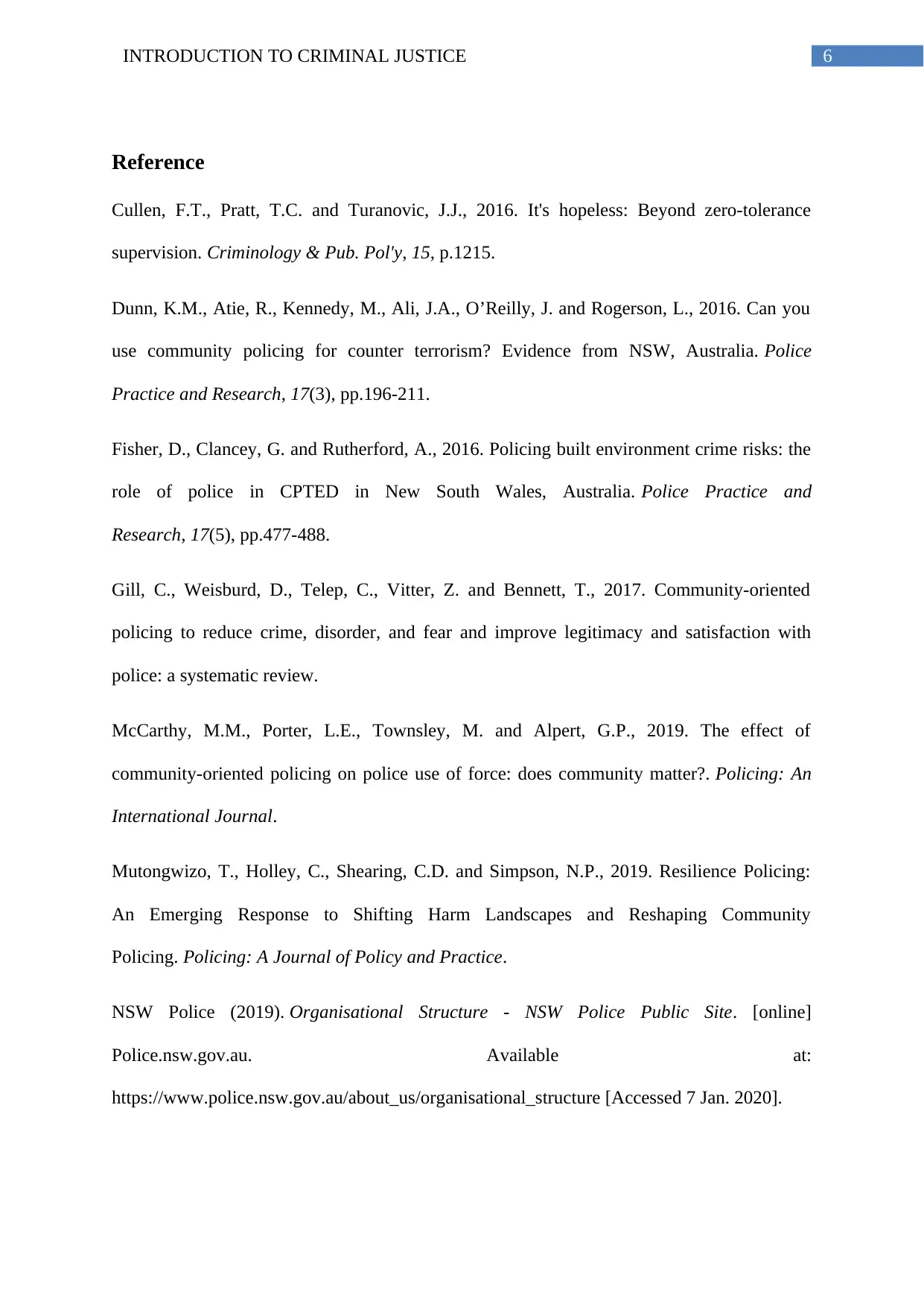
6INTRODUCTION TO CRIMINAL JUSTICE
Reference
Cullen, F.T., Pratt, T.C. and Turanovic, J.J., 2016. It's hopeless: Beyond zero-tolerance
supervision. Criminology & Pub. Pol'y, 15, p.1215.
Dunn, K.M., Atie, R., Kennedy, M., Ali, J.A., O’Reilly, J. and Rogerson, L., 2016. Can you
use community policing for counter terrorism? Evidence from NSW, Australia. Police
Practice and Research, 17(3), pp.196-211.
Fisher, D., Clancey, G. and Rutherford, A., 2016. Policing built environment crime risks: the
role of police in CPTED in New South Wales, Australia. Police Practice and
Research, 17(5), pp.477-488.
Gill, C., Weisburd, D., Telep, C., Vitter, Z. and Bennett, T., 2017. Community-oriented
policing to reduce crime, disorder, and fear and improve legitimacy and satisfaction with
police: a systematic review.
McCarthy, M.M., Porter, L.E., Townsley, M. and Alpert, G.P., 2019. The effect of
community-oriented policing on police use of force: does community matter?. Policing: An
International Journal.
Mutongwizo, T., Holley, C., Shearing, C.D. and Simpson, N.P., 2019. Resilience Policing:
An Emerging Response to Shifting Harm Landscapes and Reshaping Community
Policing. Policing: A Journal of Policy and Practice.
NSW Police (2019). Organisational Structure - NSW Police Public Site. [online]
Police.nsw.gov.au. Available at:
https://www.police.nsw.gov.au/about_us/organisational_structure [Accessed 7 Jan. 2020].
Reference
Cullen, F.T., Pratt, T.C. and Turanovic, J.J., 2016. It's hopeless: Beyond zero-tolerance
supervision. Criminology & Pub. Pol'y, 15, p.1215.
Dunn, K.M., Atie, R., Kennedy, M., Ali, J.A., O’Reilly, J. and Rogerson, L., 2016. Can you
use community policing for counter terrorism? Evidence from NSW, Australia. Police
Practice and Research, 17(3), pp.196-211.
Fisher, D., Clancey, G. and Rutherford, A., 2016. Policing built environment crime risks: the
role of police in CPTED in New South Wales, Australia. Police Practice and
Research, 17(5), pp.477-488.
Gill, C., Weisburd, D., Telep, C., Vitter, Z. and Bennett, T., 2017. Community-oriented
policing to reduce crime, disorder, and fear and improve legitimacy and satisfaction with
police: a systematic review.
McCarthy, M.M., Porter, L.E., Townsley, M. and Alpert, G.P., 2019. The effect of
community-oriented policing on police use of force: does community matter?. Policing: An
International Journal.
Mutongwizo, T., Holley, C., Shearing, C.D. and Simpson, N.P., 2019. Resilience Policing:
An Emerging Response to Shifting Harm Landscapes and Reshaping Community
Policing. Policing: A Journal of Policy and Practice.
NSW Police (2019). Organisational Structure - NSW Police Public Site. [online]
Police.nsw.gov.au. Available at:
https://www.police.nsw.gov.au/about_us/organisational_structure [Accessed 7 Jan. 2020].
Paraphrase This Document
Need a fresh take? Get an instant paraphrase of this document with our AI Paraphraser
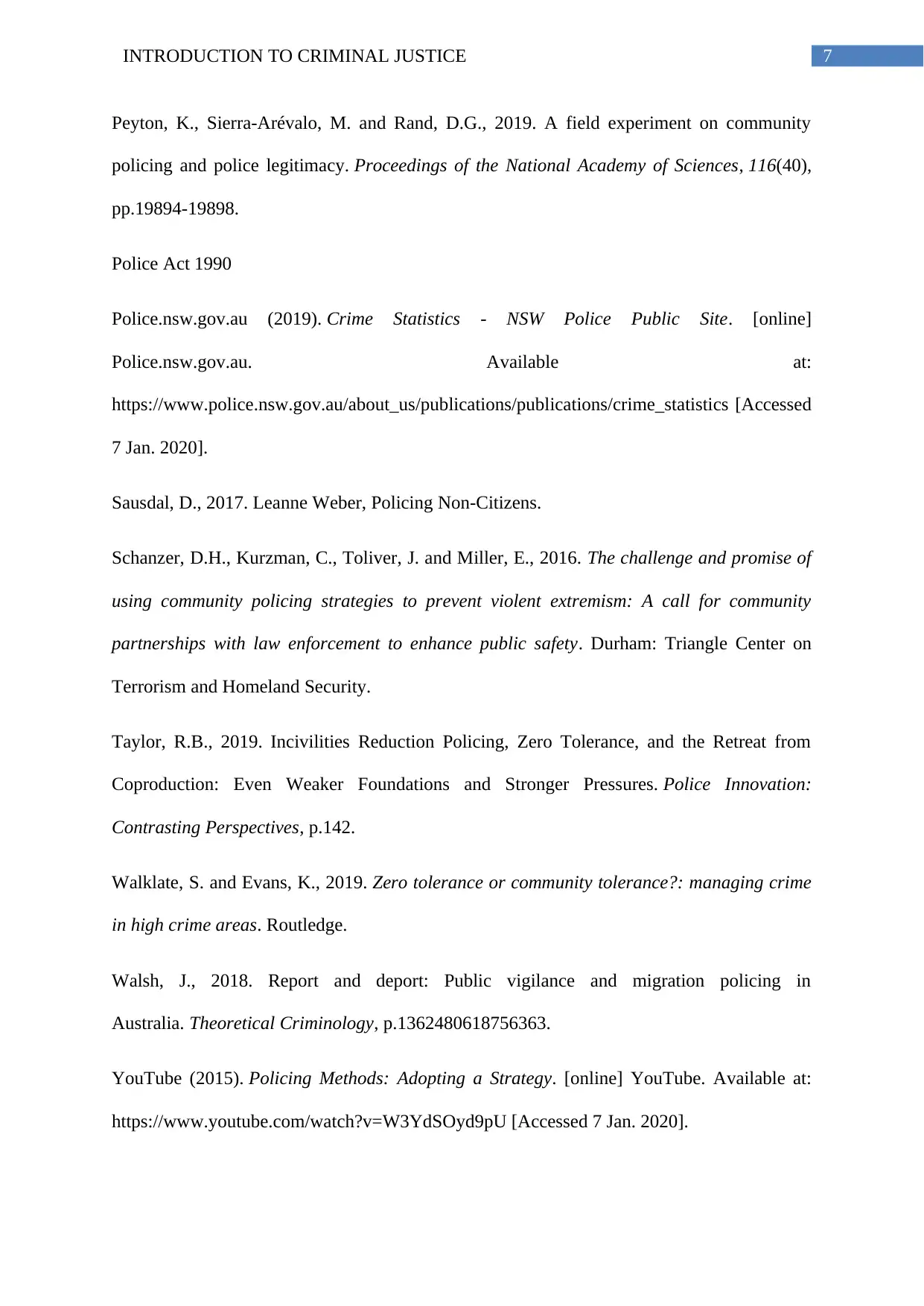
7INTRODUCTION TO CRIMINAL JUSTICE
Peyton, K., Sierra-Arévalo, M. and Rand, D.G., 2019. A field experiment on community
policing and police legitimacy. Proceedings of the National Academy of Sciences, 116(40),
pp.19894-19898.
Police Act 1990
Police.nsw.gov.au (2019). Crime Statistics - NSW Police Public Site. [online]
Police.nsw.gov.au. Available at:
https://www.police.nsw.gov.au/about_us/publications/publications/crime_statistics [Accessed
7 Jan. 2020].
Sausdal, D., 2017. Leanne Weber, Policing Non-Citizens.
Schanzer, D.H., Kurzman, C., Toliver, J. and Miller, E., 2016. The challenge and promise of
using community policing strategies to prevent violent extremism: A call for community
partnerships with law enforcement to enhance public safety. Durham: Triangle Center on
Terrorism and Homeland Security.
Taylor, R.B., 2019. Incivilities Reduction Policing, Zero Tolerance, and the Retreat from
Coproduction: Even Weaker Foundations and Stronger Pressures. Police Innovation:
Contrasting Perspectives, p.142.
Walklate, S. and Evans, K., 2019. Zero tolerance or community tolerance?: managing crime
in high crime areas. Routledge.
Walsh, J., 2018. Report and deport: Public vigilance and migration policing in
Australia. Theoretical Criminology, p.1362480618756363.
YouTube (2015). Policing Methods: Adopting a Strategy. [online] YouTube. Available at:
https://www.youtube.com/watch?v=W3YdSOyd9pU [Accessed 7 Jan. 2020].
Peyton, K., Sierra-Arévalo, M. and Rand, D.G., 2019. A field experiment on community
policing and police legitimacy. Proceedings of the National Academy of Sciences, 116(40),
pp.19894-19898.
Police Act 1990
Police.nsw.gov.au (2019). Crime Statistics - NSW Police Public Site. [online]
Police.nsw.gov.au. Available at:
https://www.police.nsw.gov.au/about_us/publications/publications/crime_statistics [Accessed
7 Jan. 2020].
Sausdal, D., 2017. Leanne Weber, Policing Non-Citizens.
Schanzer, D.H., Kurzman, C., Toliver, J. and Miller, E., 2016. The challenge and promise of
using community policing strategies to prevent violent extremism: A call for community
partnerships with law enforcement to enhance public safety. Durham: Triangle Center on
Terrorism and Homeland Security.
Taylor, R.B., 2019. Incivilities Reduction Policing, Zero Tolerance, and the Retreat from
Coproduction: Even Weaker Foundations and Stronger Pressures. Police Innovation:
Contrasting Perspectives, p.142.
Walklate, S. and Evans, K., 2019. Zero tolerance or community tolerance?: managing crime
in high crime areas. Routledge.
Walsh, J., 2018. Report and deport: Public vigilance and migration policing in
Australia. Theoretical Criminology, p.1362480618756363.
YouTube (2015). Policing Methods: Adopting a Strategy. [online] YouTube. Available at:
https://www.youtube.com/watch?v=W3YdSOyd9pU [Accessed 7 Jan. 2020].
1 out of 8
Related Documents
Your All-in-One AI-Powered Toolkit for Academic Success.
+13062052269
info@desklib.com
Available 24*7 on WhatsApp / Email
![[object Object]](/_next/static/media/star-bottom.7253800d.svg)
Unlock your academic potential
Copyright © 2020–2025 A2Z Services. All Rights Reserved. Developed and managed by ZUCOL.





